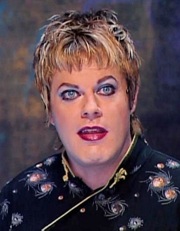With the increasing acceptance of gay marriage, there’s a temptation to think that we as a society have basically done away with all relevant forms of discrimination. “Hey, we abolished slavery, gave women the vote, and let gay people get married! Perfect equality has finally been achieved.”
Then you read something depressing like this opinion piece in The American Conservative, and are jolted back to reality. It spins off an NPR piece on, naturally, those crazy college youths and their mixed-up ideas. Margot Adler reported on the trend among students to identify themselves not only by their name, but also by what pronouns they like to be called by.
Depending on what street corners you hang out on, you might not be aware that pronouns are an issue. Guys are he/him, and gals are she/her, right?
Of course that only makes sense if you buy into the idea that there are guys, and there are gals, and that’s just about all there is. But the reality is much more richly complex — and that’s a reality to which our society has not yet caught up.
My lovely wife Jennifer has a new book coming out next year — Me, Myself, and Why: Searching for the Science of Self. One of her chapters is on gender and sexuality — what it is, how it comes about, and how it gets expressed. Once you actually look at the science behind it all, rather than assuming that the categories bequeathed to you as a child represent universal truths, you quickly realize that this stuff is as complicated as all get-out. (That’s how the youths these days talk, right?)
 Talking with Jennifer as she wrote her chapter (which, as usual for her, involved reading a pile of technical papers as well as interviewing many experts) led me to propose the Gender Tesseract. (I’m hoping this becomes a symbol of inclusiveness and understanding, and we sell bushels of T-shirts and bumper stickers.) A tesseract, as readers well know, is the four-dimensional equivalent of a cube. And roughly — very roughly, because these ideas arise from the human desire to stick things into categorical boxes, not from any fixed nature of reality — there are four important dimensions of gender/sexuality to be considered:
Talking with Jennifer as she wrote her chapter (which, as usual for her, involved reading a pile of technical papers as well as interviewing many experts) led me to propose the Gender Tesseract. (I’m hoping this becomes a symbol of inclusiveness and understanding, and we sell bushels of T-shirts and bumper stickers.) A tesseract, as readers well know, is the four-dimensional equivalent of a cube. And roughly — very roughly, because these ideas arise from the human desire to stick things into categorical boxes, not from any fixed nature of reality — there are four important dimensions of gender/sexuality to be considered:
- Gender Identity: how you think of yourself.
- Gender Expression: how you dress/act/present yourself to the world.
- Sexual Orientation: to whom you are attracted.
- Biological Sex: what body parts you have. (Forgot about that one, didn’t you?)
 In principle, all of these can be completely different for an individual person. Comedian Eddie Izzard, although he tends to perform in “boy mode” these days, has frequently appeared in women’s clothing — his gender expression (at least as far as clothes were concerned) was female. But he isn’t gay; his sexual orientation is toward (biological/self-identified) women. There shouldn’t be any problem imagining a person (for example) who is biologically female and wears what we think of as women’s clothing, but who thinks of themselves as male and is attracted to
In principle, all of these can be completely different for an individual person. Comedian Eddie Izzard, although he tends to perform in “boy mode” these days, has frequently appeared in women’s clothing — his gender expression (at least as far as clothes were concerned) was female. But he isn’t gay; his sexual orientation is toward (biological/self-identified) women. There shouldn’t be any problem imagining a person (for example) who is biologically female and wears what we think of as women’s clothing, but who thinks of themselves as male and is attracted to women people who are biologically female. All the vertices of the tesseract are open for business.
And of course the reality is infinitely more complicated than that. There’s no reason to locate one’s self at a vertex of the tesseract, rather than somewhere in the interior; yes, Virginia, there are bisexuals. And indeed there are asexuals and pansexuals and countless other variations. Even before I open my T-shirt store, the Gender Tesseract is hopelessly out of date. (Perhaps we should think of functions defined on the tesseract, rather than simply points within it.) As a member of the most boring, socially normative category, I try to keep in mind that I’m not an expert on other people’s sexuality and identity, and listen to what they have to say rather than telling them how to behave.
Which is tricky, because society loves telling you how to behave. Sometimes explicitly, sometimes indirectly. The most powerful indirect tool society has is language.
The idea of a unique gender binary — men, women, no other categories — is built into English and many other languages. Women are “she,” men are “he,” and there aren’t any other possibilities. Perhaps you don’t know whether a person you are talking about is male or female, in which case society has a rule for you: assume they are male, and refer to them as “he.”
That last one is actually pretty easy to fix. For a long time now, many people have used “they” as a singular pronoun in cases where the person being referred to is of unknown gender. I started using it years ago, and it works fine. (Following in the footsteps here of Shakespeare and Jane Austen, so I’m not exactly a trailblazer.) But what about when you know exactly who you are talking about, and that person doesn’t want to accept a simplistic gender binary?
Thus the quest for gender-neutral pronouns. This is a very tricky subject, as language always is — especially for something so anarchic as English, where there isn’t any central governing body that lays down the law. In English, anyone is allowed to just make up words, so people certainly have. One choice that is popular in the transgender community is to substitute ze for he/she and zir (pronounced “zeer”) for him/his/her. These neologisms can seem strained at first use, but there’s a chance they will catch on and eventually seem perfectly natural. I was intrigued (and pleased) to learn that some college kids are pushing the idea forward. We’ll see how it goes.
Rod Dreher, author of the American Conservative piece, was less pleased. It is in the nature of conservatism to resist change, so that shouldn’t come as much of surprise. What’s depressing is the sheer lazy stupidity of the “critique.” Actually there’s not much critique at all — Dreher merely points at something he doesn’t understand, and kind of giggles uncomfortably. He labels the students “deeply confused people,” and the sum of his counterargument is one word: “Honestly?”
Yes, honestly. Language matters, and matching how we speak about people to how they think about themselves is an important part of human dignity. I don’t know what the best linguistic solution is for the knotty realities of human gender and sexuality, but I welcome the attempts to do better. Perfect equality has not yet been achieved, but I like to think we’re moving in a good direction.
I’m rather fond Orion’s Arm’s approach to the problem (http://www.orionsarm.com/eg-article/495360fba7a46), although personally I’d favor discarding all but the e/em/eir/eirs pronouns, just for simplicity’s sake.
just realized that my previous comment makes very little sense. I guess that’s what happens after a 16 hour shift at work during finals week.
Some years ago I saw a short article (in In These Times IIRC)
entitled “E’s got a new pronoun, blimey!”
“…society loves telling you how to behave. Sometimes explicitly, sometimes indirectly. The most powerful indirect tool society has is language.”
Well, of course; it’s been happening probably since we came down from the trees…
We have to distinguish different kinds of things in order to reason consistently about the world, as Bertrand Russell showed with his paradoxical set of all sets which are not members of themselves.
Perhaps “biological sex” should be called “anatomical sex” because gender chromosomes and gender anatomy do not always match. That said, we should stick to 4D gender despite chromosomal variation that might or might not affect the dimensions.
Another reason for changing “biological sex” to “anatomical sex” is to avoid suggesting that biology affects only the hardware but not the software.